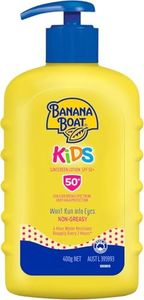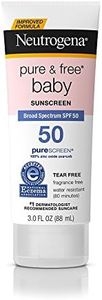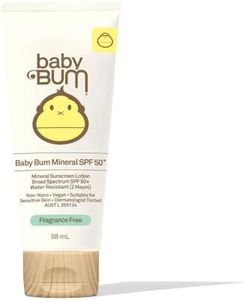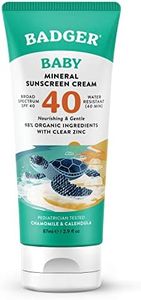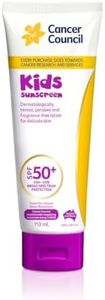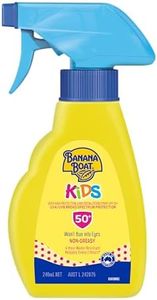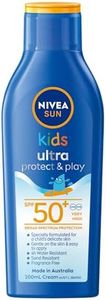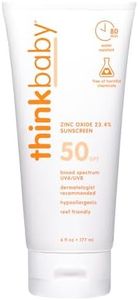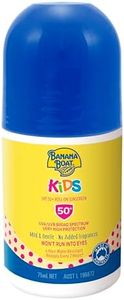We Use CookiesWe use cookies to enhance the security, performance,
functionality and for analytical and promotional activities. By continuing to browse this site you
are agreeing to our privacy policy
10 Best Sunscreens For Babies
From leading brands and best sellers available on the web.Buying Guide for the Best Sunscreens For Babies
Choosing a sunscreen for babies is an important decision because infants have delicate and sensitive skin that needs extra protection from the sun’s harmful rays. When looking for a sunscreen for your baby, prioritize products that offer thorough protection while being gentle and safe for young skin. Understanding the key specifications will help you ensure that your baby’s skin remains healthy, comfortable, and well-protected during outdoor activities.SPF (Sun Protection Factor)SPF stands for Sun Protection Factor and measures how well a sunscreen protects skin from UVB rays, which cause sunburn and contribute to skin damage. For babies, a higher SPF means greater protection, but generally, SPF 30 and above is recommended. Lower SPFs (below 15) are less effective and not ideal for babies, while SPFs like 30, 45, or 50 offer strong protection. Choose a higher SPF if your baby will be outdoors for longer periods or under intense sunlight, but remember that no sunscreen blocks 100% of UV rays, and reapplication is always important.
Type of Sunscreen (Mineral vs. Chemical)Sunscreens can be mineral (physical) or chemical. Mineral sunscreens use ingredients like zinc oxide or titanium dioxide to create a physical barrier that reflects UV rays, while chemical sunscreens absorb UV rays through chemical reactions. For babies, mineral sunscreens are generally preferred because they are less likely to irritate sensitive skin and start working immediately upon application. Reading the ingredient list will tell you which category the sunscreen falls into, and for infants under six months, it’s best to consult with a pediatrician before using any sunscreen.
Broad Spectrum ProtectionBroad spectrum means the sunscreen protects against both UVA (which ages the skin) and UVB (which burns the skin) rays. Both types of rays can be damaging, so broad spectrum protection is crucial for comprehensive defense. Look for products that clearly state 'broad spectrum' on the label, as this ensures your baby is protected from the wider range of sun damage.
Water ResistanceWater resistance in sunscreen refers to how well the product stays effective when exposed to water from swimming or sweating. Water-resistant sunscreens provide protection for a certain period (usually 40 or 80 minutes) after exposure to water, indicated on the label. If you expect your baby to be in water or sweating, a water-resistant formula adds an extra layer of reassurance. However, remember to reapply sunscreen as directed, especially after towel drying.
Hypoallergenic and Fragrance-FreeHypoallergenic and fragrance-free sunscreens are formulated to reduce the risk of allergic reactions and irritation, which is especially important for babies with sensitive or eczema-prone skin. Products labeled as such are less likely to cause redness or rashes. If your baby has a history of skin sensitivity, choosing sunscreens free from added fragrances and harsh chemicals is a safer option.
Formulation (Lotion, Stick, or Spray)Sunscreens come in forms like lotions, sticks, and sprays. Lotions are common, easy to apply evenly, and are often the gentlest choice for babies. Sticks are convenient for small areas such as the face, while sprays should generally be avoided for babies because they can be inhaled and are harder to control. When picking a formulation, consider how easily you can apply it to your baby’s skin and whether it’s suitable for touch-ups during the day.



